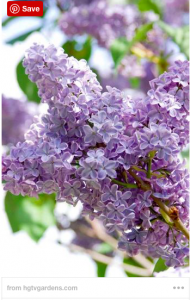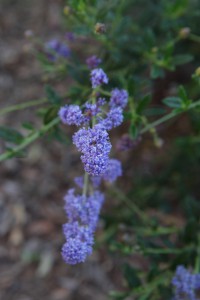The Battle Between East and West
The fragrance of Eastern Lilacs drifted through Farmer’s Markets this week. Whether you crave that delicious lilac scent, get transfixed by lilac’s bodacious blooms, or need a hedge that offers one or both of the preceding characteristics, scintillating scent-a-licious California natives provide alternatives.

 Eastern Lilac, Syringa vulgaris
Eastern Lilac, Syringa vulgaris
A long time favorite in California gardens, the lightly fragrant light pink blooms of Eastern Lilac, (Syringa vulgaris) mean spring is in full swing. The blooms seem so familiar, who would guess they originate in Eastern Europe and Asia?
While we find Eastern Lilacs throughout California, they perform best in climates where a frost occurs – they need their beauty sleep! Lilac health and beauty come spring depends on this dormant period. On the coast only very low chill variety will be more than stick-like creatures with a few blooms.
While, in prime conditions, you may get a statuesque light green bush around 8-12′ tall and wide with striking blooms for a couple of weeks each year, disease can shorten this already tight bloom cycle.
Lilacs partner well with roses and other seasonally thirsty plants. While traditional grasses meet the thirsty-companion criteria, planting lilacs near near lawns can lead to diseases like powdery mildew due to overwatering.
 California Lilac, Ceanothus sp.
California Lilac, Ceanothus sp.
Selecting one of the hundreds of native wild lilacs or Ceanothus will bring blooms as early as February and as long as late summer. Perfect for a drought year, Ceanothus do not like to be overwatered! They can tolerate very dry and poor soils boasting delicately lovely white, powdery blue, deepest sky blue or light pink gum-drop shaped blooms even under the worst of conditions.
California lilacs have tremendous flexibility – thriving from coastal scrub to chaparral to mixed evergreen and even lower alpine and oak woodland areas. Some form full size bushes like their eastern counterparts, making beautiful year-round green screens, others form low and wide groundcovers.
California lilac grow bountifully and live long lives, in contrast to rumor. It’s important to give them room to grow, as they often expand beyond what reference books indicate. To get a sense of their natural growth, see the blue flowering lilacs beginning to bloom in March on north-facing slopes or the white bloomed varieties that enliven south facing slopes as spring progresses.
For a hedge, Ceanothus partners well with Toyon and Bay. To bring a  contrast of color with lower growing Ceanothus, its colors pop next to white sage.
contrast of color with lower growing Ceanothus, its colors pop next to white sage.
If the Eastern Lilac’s cone shaped flowers charm you more than lilac’s sensational scent or green screen capabilities, check out California native Lupine for yet another possible exchange.
Each of these plants is available at Theodore Payne Foundation and Las Pilitas Nurseries.